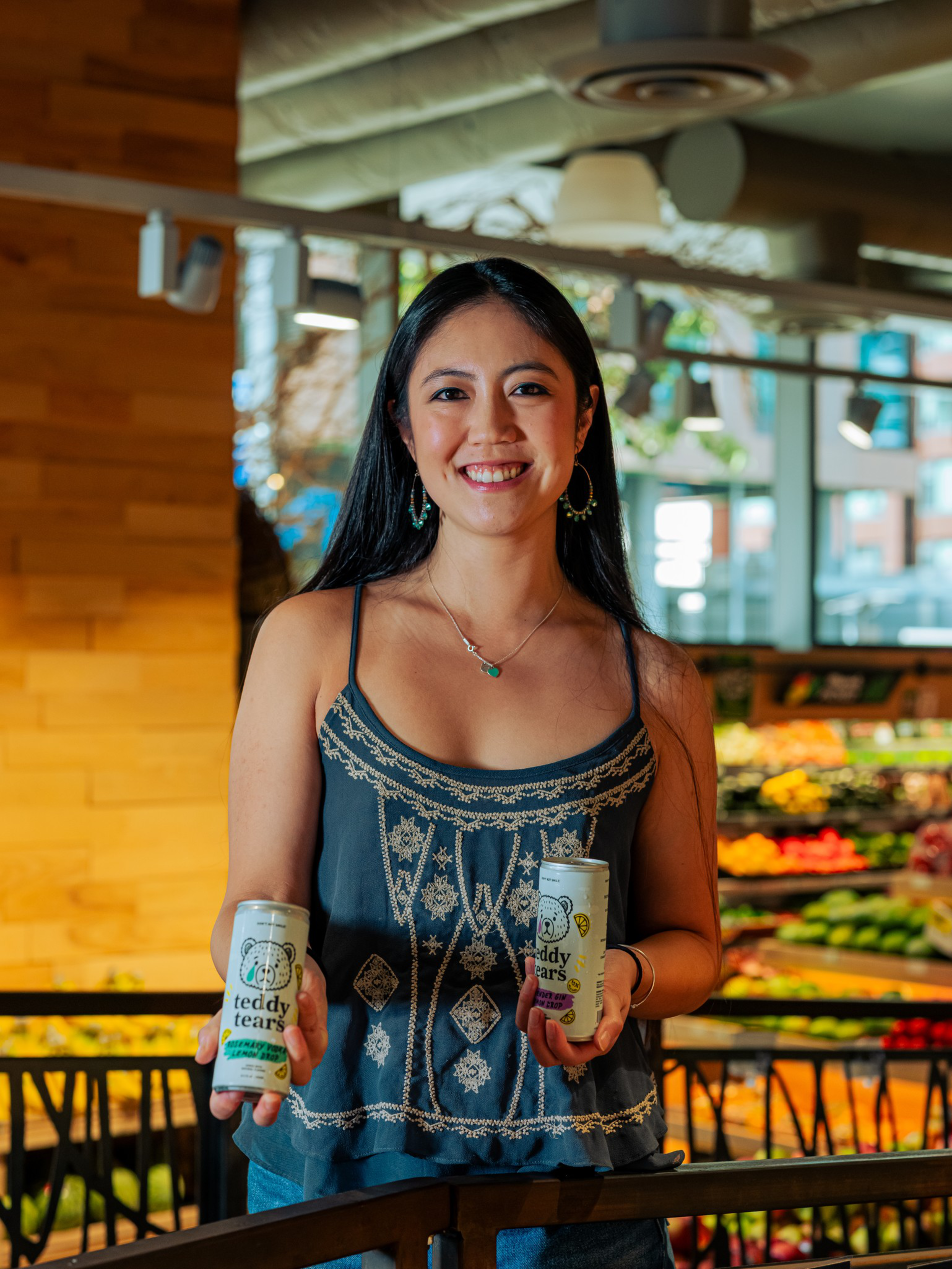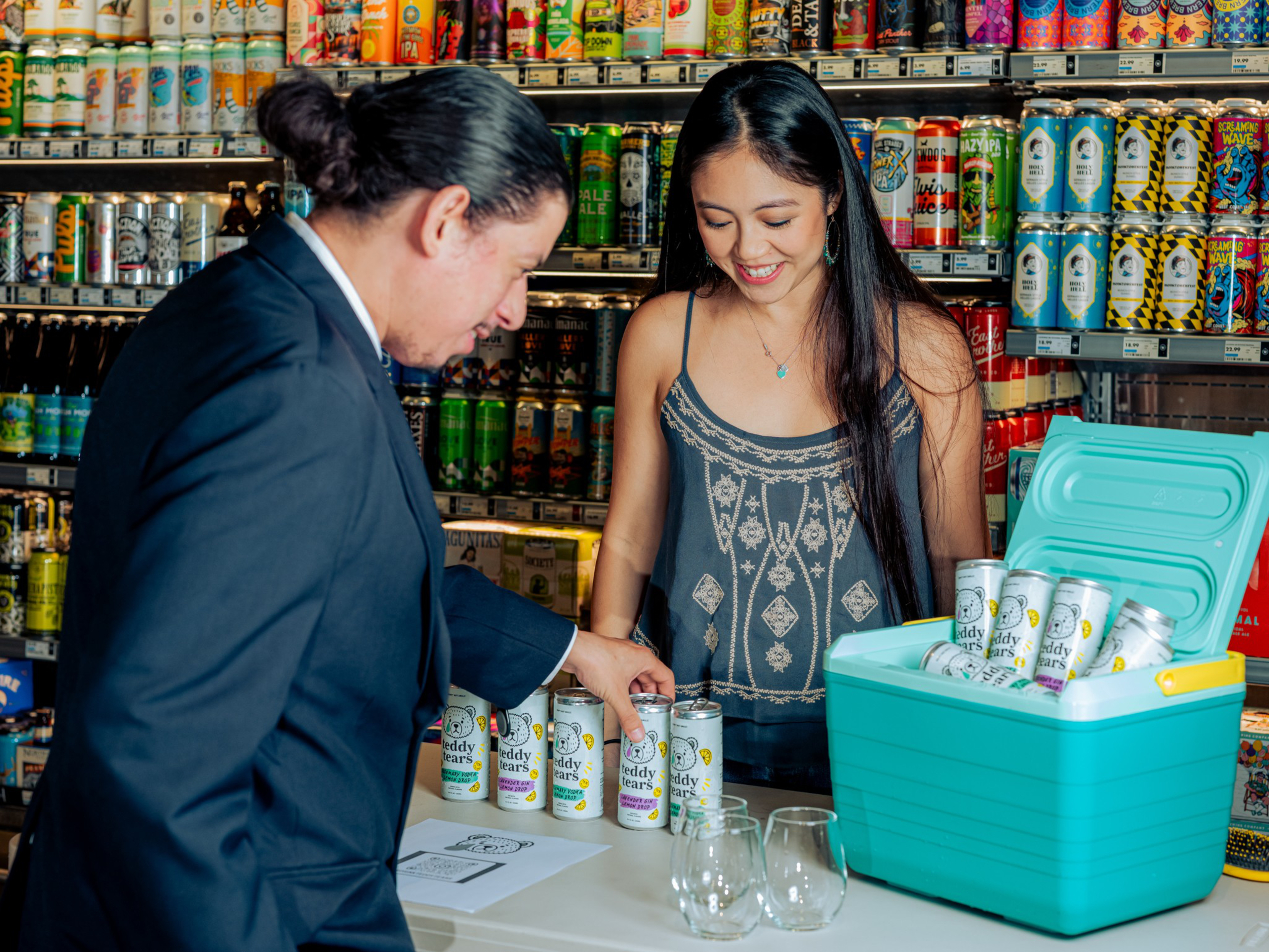At the ritzy Rincon Hill grocery store Woodlands Market on Sept. 4, Vivian Xie, dressed in a flowing boho top and denim miniskirt, handed out canned lemon-drop cocktail samples to shoppers. “These are really good,” said Johnny, a quality-control manager who declined to share his last name. “I would be convinced you put a bunch of syrups in there, because it’s real sweet.”
Nope, just all-natural cane sugar, responded Xie, 30, the Berkeley-based founder of Teddy Tears (opens in new tab), a new Bay Area brand selling canned 15% ABV lemon drops.
The can features a cute-but-melancholic teddy bear, rendered in clean graphic lines, with an oversize teardrop sliding down its cheek. Two flavors of lemon drop — lavender gin and rosemary vodka — were on offer; a third variety, smoky bourbon, which tastes like a cold hot toddy, debuts in October. A four-pack costs $19.99 (opens in new tab); singles are $7-$8.
This was Teddy Tears’ first in-store tasting, as the cans hit shelves in late August. They’re now stocked at three Woodlands locations, both Berkeley Bowl outposts, and four Total Wine & More outlets — plus they’re soon to arrive at 40 BevMo stores across Northern California. “People are begging for something other than seltzers,” Xie said between pours. “But I didn’t think it would happen so quickly. … I started cold emails in January.”



Ready-to-drink cocktails are on the rise
A high-ABV canned cocktail startup in a town that’s famously dialing back on drinking seems like an odd choice. But despite Gen Z’s preference for matcha over martinis, Xie has tapped into the one category bucking the sober-down trend: ready-to-drink, or RTD, canned cocktails.
Yes, San Franciscans may drink less than they used to, but the RTD category is exploding, especially in California, where sales nearly doubled (opens in new tab) between 2019 and 2024 — exceeding U.S. growth rates. (opens in new tab) The national market hit $903.4 million in 2024 and is forecast to grow 15.3% annually through 2030. (opens in new tab) The draw is simple: convenience. These are cocktails you can carry from parks to parties to your own comfy couch.
Teddy Tears’ high 15% ABV — in contrast, High Noon and White Claw clock in around 5%, while the most high-octane Cutwater flavor achieves 13% — was a selling point for Randy Ornstein, the senior director of beverages at Gopuff, which owns BevMo. “The over-12% ABV category is our fastest-growing, showing a year-over-year growth of over 120%,” he said. The retailer is expanding its RTD shelf space by 20% to 40%. Teddy Tears’ design and flavor profile sealed the deal for Ornstein who was convinced they “would pop on the shelf.” Or, perhaps, the screen, since Gopuff delivers (opens in new tab).
In January, Xie quit her role as a product manager at Truewind, a Y Combinator-backed AI accountancy startup, to bootstrap Teddy Tears from her bedroom. “Leaving tech, and not having that stable tech money, was very hard,” she said. But the leap from software to spirits didn’t intimidate her. “It’s harder to onboard people for software than for drinks,” she said. “Alcohol sells itself.”

Rapid development
Xie, a first-time solo founder, is new to the beverage world — her résumé includes stints in product marketing and growth for ThredUp, 500 Startups, and Veryfi, an AI data-extraction startup. It was her post-undergrad bartending shifts at now-closed Hakkasan in the Financial District that planted the seed. “Lemon drops are some of the most requested drinks,” she said. “The only canned ones were artificial.”
In 2022, she began mixing cocktails in her kitchen, testing recipes on friends and running Airbnb cocktail-making classes that doubled as focus groups. She learned that guests preferred less-sweet profiles with one dominant fruit note. Rosemary and lavender survived; anise and elderflower did not.
In October 2024, she mailed her cocktail recipes to a formulation lab, and after multiple iterations, finalized the blends this spring. Then came the federal gauntlet of Alcohol and Tobacco Tax and Trade Bureau approvals, label clearance, and sourcing packers, cans, and ingredients. Some ingredients need to be refrigerated for 45 days, then thawed for two. “On complexity, it’s a 9 out of 10,” she says. “So many moving parts.”
Teddy Tears’ launch was unusually fast by consumer packaged goods standards, said Michelle Regan, R&D director at KitchenTown (opens in new tab), a food-product development lab in San Mateo. Big brands can take three or more years to develop a product and about 18 months to create a new flavor, she explained. Startups are more nimble but face regulatory hurdles. “Having no experience [and] on shelf in nine months is definitely an outlier,” said Thomas Taylor, KitchenTown’s operations director. “I’m impressed.”

A cocktail that fits in your bag
For Xie, that timeline meant compressing years of work, a sprint she admits was grueling. “It’s a big risk for any [packaged good],” she said. “If I don’t nail the first five production runs at these big retailers, the growth really is hard to sustain afterward.”
In terms of the name, she almost went with Bunny Tears before landing on the alliterative teddy. The crying bear is her ironic twist in a category obsessed with cheerful branding. “Drinks should bring joy, not just get you buzzed,” she said, a message echoed on every can: “Don’t Not Smile. On the reverse, each can states: “You are the main character.” In a world obsessed with creepy-cute Labubus, the sad-cute mascot “really sticks in people’s memories,” she said.
‘If we can make a better lemon drop that fits in your bag — and actually tastes like a cocktail — I think people will come back.’
Vivian Xie
Investors are betting she’s right. In May, Xie landed her first angel, Michael Luu, a Canadian options trader who usually backs tech startups. He was drawn to the brand because of the quality and taste and because he admired Xie’s hustle. “If people do drink, they want something fresh and delicious with amazing ingredients. That’s what I’m betting on,” he said. He declined to share his investment but said his checks typically range from $100,000 to $200,000.
That vote of confidence helps, but Xie knows the odds. “I knew I wanted to put something into the world people actually enjoy,” she said. “If we can make a better lemon drop that fits in your bag — and actually tastes like a cocktail — I think people will come back.”
